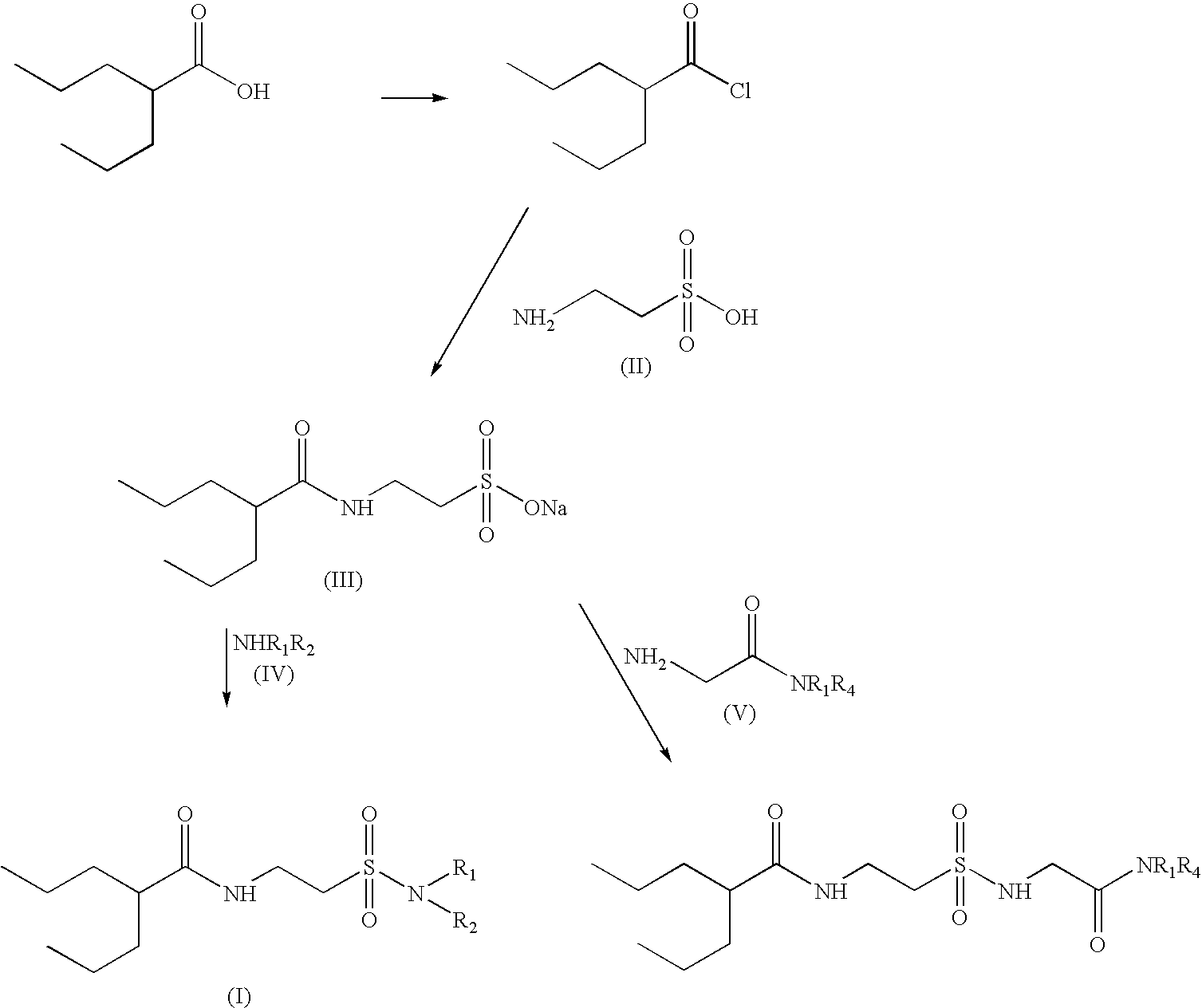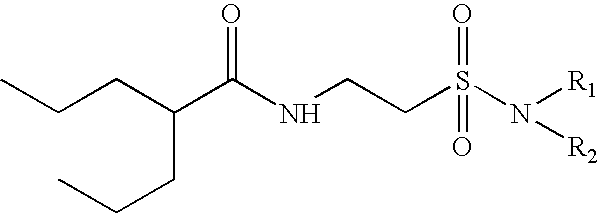Valproyltaurinamide derivatives as anticonvulsant amd CNS active agents
a technology of valproic acid and taurinamide, which is applied in the field of derivatives of valproic acid and taurine, can solve the problems of clinical uselessness, potential for fatal hepatotoxicity, and 25% of patients who do not respond to current medications
- Summary
- Abstract
- Description
- Claims
- Application Information
AI Technical Summary
Benefits of technology
Problems solved by technology
Method used
Image
Examples
example 1
N(2-n-Propylpentanoyl)taurine Na (compound of formula (III) in the diagram above)
[0035]Valproyl chloride (47.4 g, 0.29 mol) was added dropwise to an ice-cooled solution of taurine (36.5 g, 0.29 mol) and NaOH (15 g) in water (100 ml). Cooling was discontinued and the two-phase mixture was stirred at RT overnight, acidified to pH 3 with 5M HCl. The mixture was concentrated using reduced pressure and the slurry was treated with 500 ml boiling ethanol. The insoluble salts were filtered off and the product crystallized from ethanol affording 50 g (0.18 mol, 63%) of the title compound as white solid, mp 250° C.
[0036]1H NMR ä (D2O): 5.59 (t, 2H, NHCH2CH2SO2), 2.95 (t, 2H, CH2CH2SO2), 2.16 (m, 1H, pr2CHCO), 1.54 (m, 4H, CH3CH2CH2), 1.31 (m, 4H, CH3CH2CH2), 0.90 (t, 6H, CH3CH2CH2) ppm.
[0037]IR (KBr): 3313, 3092, 2957, 2873, 1629, 1564, 1455, 1378, 1255, 1218, 1121, 1051 cm−1
example 2
N(2-n-Propylpentanoyl)taurineamide
[0038]Thionyl chloride (19.6 g, 0.165 mol) was added to a solution of dry valproyl taurine (compound III) (15 g, 0.055 mol) prepared according to Ex 1, in dry CH2Cl2 (200 ml). The reaction mixture was stirred in 50° C. for 12 hours. The excess of CH2Cl2 and thionyl chloride was then distilled using reduced pressure and the residue containing the product N-(2-n-Propylpentanoyl)taurinyl chloride dissolved to 30 ml dry CH2Cl2. N-(2-n-Propylpentanoyl)taurinyl chloride (5.2 g, 0.018 mol) in 15 ml of dry dichloromethane was added dropwise to ice-cooled 25% aqueous ammonia (100 ml). The reaction was stirred at RT for 2 hrs. The layers were then separated and the aqueous layer extracted with EtOAc. The combined organic layers were washed succesfully with water, dried and evaporated to dryness. The residue was treated with chloroform (100 ml), and the resultant chrystals were collected by filtration washed with hexane and dried to give 4 g (0.016 mol, 89%) o...
example 3
N(2-n-Propylpentanoyl)taurine-N′-methylamide
[0043]The title compound was prepared from valproyl taurine (4 g, 0.0146 mol) and aqueous N-methylamine (1.36 g, 0.0439 mol) according to the procedure described in example 2.3 g (0.0113 mol, 78%) of a white solid, mp 94° C., was thus obtained.
[0044]Anal calc. for (C11H24N2O3S) C, 49.96%; H, 9.17%; N, 10.60%.
[0045]Found: C, 50.25%; H, 8.84%; N, 10.47%.
[0046]1H NMR ä (CDCl3, 1% TMS): 6.43 (br t, 1H, CONH), 5.00 (br d, 1H, SO2NH), 3.73 (q, 2H, NHCH2CH2SO2), 3.21 (q, 2H, CH2CH2SO2), 2.81 (d, 3H, SO2NHCH3), 2.09 (m, 1H, pr2CHCO), 1.57, 1.38 (m, 4H, CH3CH2CH2), 1.29 (m, 4H, CH3CH2CH2), 0.89 (t, 6H, CH3CH2CH2) ppm.
PUM
| Property | Measurement | Unit |
|---|---|---|
| temperature | aaaaa | aaaaa |
| temperature | aaaaa | aaaaa |
| pH | aaaaa | aaaaa |
Abstract
Description
Claims
Application Information
 Login to View More
Login to View More - R&D
- Intellectual Property
- Life Sciences
- Materials
- Tech Scout
- Unparalleled Data Quality
- Higher Quality Content
- 60% Fewer Hallucinations
Browse by: Latest US Patents, China's latest patents, Technical Efficacy Thesaurus, Application Domain, Technology Topic, Popular Technical Reports.
© 2025 PatSnap. All rights reserved.Legal|Privacy policy|Modern Slavery Act Transparency Statement|Sitemap|About US| Contact US: help@patsnap.com



